Huabin Zheng
Kimi Linear: An Expressive, Efficient Attention Architecture
Oct 30, 2025Abstract:We introduce Kimi Linear, a hybrid linear attention architecture that, for the first time, outperforms full attention under fair comparisons across various scenarios -- including short-context, long-context, and reinforcement learning (RL) scaling regimes. At its core lies Kimi Delta Attention (KDA), an expressive linear attention module that extends Gated DeltaNet with a finer-grained gating mechanism, enabling more effective use of limited finite-state RNN memory. Our bespoke chunkwise algorithm achieves high hardware efficiency through a specialized variant of the Diagonal-Plus-Low-Rank (DPLR) transition matrices, which substantially reduces computation compared to the general DPLR formulation while remaining more consistent with the classical delta rule. We pretrain a Kimi Linear model with 3B activated parameters and 48B total parameters, based on a layerwise hybrid of KDA and Multi-Head Latent Attention (MLA). Our experiments show that with an identical training recipe, Kimi Linear outperforms full MLA with a sizeable margin across all evaluated tasks, while reducing KV cache usage by up to 75% and achieving up to 6 times decoding throughput for a 1M context. These results demonstrate that Kimi Linear can be a drop-in replacement for full attention architectures with superior performance and efficiency, including tasks with longer input and output lengths. To support further research, we open-source the KDA kernel and vLLM implementations, and release the pre-trained and instruction-tuned model checkpoints.
Kimi K2: Open Agentic Intelligence
Jul 28, 2025Abstract:We introduce Kimi K2, a Mixture-of-Experts (MoE) large language model with 32 billion activated parameters and 1 trillion total parameters. We propose the MuonClip optimizer, which improves upon Muon with a novel QK-clip technique to address training instability while enjoying the advanced token efficiency of Muon. Based on MuonClip, K2 was pre-trained on 15.5 trillion tokens with zero loss spike. During post-training, K2 undergoes a multi-stage post-training process, highlighted by a large-scale agentic data synthesis pipeline and a joint reinforcement learning (RL) stage, where the model improves its capabilities through interactions with real and synthetic environments. Kimi K2 achieves state-of-the-art performance among open-source non-thinking models, with strengths in agentic capabilities. Notably, K2 obtains 66.1 on Tau2-Bench, 76.5 on ACEBench (En), 65.8 on SWE-Bench Verified, and 47.3 on SWE-Bench Multilingual -- surpassing most open and closed-sourced baselines in non-thinking settings. It also exhibits strong capabilities in coding, mathematics, and reasoning tasks, with a score of 53.7 on LiveCodeBench v6, 49.5 on AIME 2025, 75.1 on GPQA-Diamond, and 27.1 on OJBench, all without extended thinking. These results position Kimi K2 as one of the most capable open-source large language models to date, particularly in software engineering and agentic tasks. We release our base and post-trained model checkpoints to facilitate future research and applications of agentic intelligence.
Divide-Fuse-Conquer: Eliciting "Aha Moments" in Multi-Scenario Games
May 22, 2025Abstract:Large language models (LLMs) have been observed to suddenly exhibit advanced reasoning abilities during reinforcement learning (RL), resembling an ``aha moment'' triggered by simple outcome-based rewards. While RL has proven effective in eliciting such breakthroughs in tasks involving mathematics, coding, and vision, it faces significant challenges in multi-scenario games. The diversity of game rules, interaction modes, and environmental complexities often leads to policies that perform well in one scenario but fail to generalize to others. Simply combining multiple scenarios during training introduces additional challenges, such as training instability and poor performance. To overcome these challenges, we propose Divide-Fuse-Conquer, a framework designed to enhance generalization in multi-scenario RL. This approach starts by heuristically grouping games based on characteristics such as rules and difficulties. Specialized models are then trained for each group to excel at games in the group is what we refer to as the divide step. Next, we fuse model parameters from different groups as a new model, and continue training it for multiple groups, until the scenarios in all groups are conquered. Experiments across 18 TextArena games show that Qwen2.5-32B-Align trained with the Divide-Fuse-Conquer strategy reaches a performance level comparable to Claude3.5, achieving 7 wins and 4 draws. We hope our approach can inspire future research on using reinforcement learning to improve the generalization of LLMs.
Kimi-VL Technical Report
Apr 10, 2025

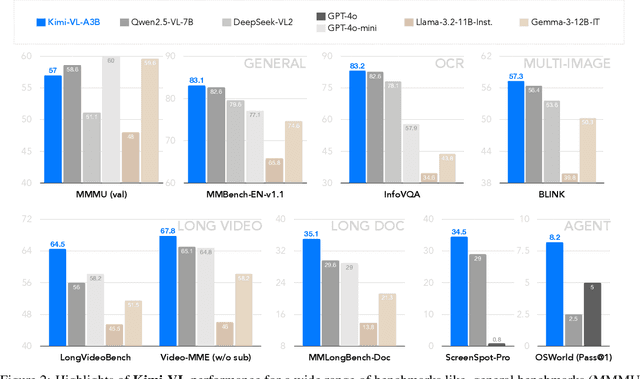

Abstract:We present Kimi-VL, an efficient open-source Mixture-of-Experts (MoE) vision-language model (VLM) that offers advanced multimodal reasoning, long-context understanding, and strong agent capabilities - all while activating only 2.8B parameters in its language decoder (Kimi-VL-A3B). Kimi-VL demonstrates strong performance across challenging domains: as a general-purpose VLM, Kimi-VL excels in multi-turn agent tasks (e.g., OSWorld), matching flagship models. Furthermore, it exhibits remarkable capabilities across diverse challenging vision language tasks, including college-level image and video comprehension, OCR, mathematical reasoning, and multi-image understanding. In comparative evaluations, it effectively competes with cutting-edge efficient VLMs such as GPT-4o-mini, Qwen2.5-VL-7B, and Gemma-3-12B-IT, while surpassing GPT-4o in several key domains. Kimi-VL also advances in processing long contexts and perceiving clearly. With a 128K extended context window, Kimi-VL can process diverse long inputs, achieving impressive scores of 64.5 on LongVideoBench and 35.1 on MMLongBench-Doc. Its native-resolution vision encoder, MoonViT, further allows it to see and understand ultra-high-resolution visual inputs, achieving 83.2 on InfoVQA and 34.5 on ScreenSpot-Pro, while maintaining lower computational cost for common tasks. Building upon Kimi-VL, we introduce an advanced long-thinking variant: Kimi-VL-Thinking. Developed through long chain-of-thought (CoT) supervised fine-tuning (SFT) and reinforcement learning (RL), this model exhibits strong long-horizon reasoning capabilities. It achieves scores of 61.7 on MMMU, 36.8 on MathVision, and 71.3 on MathVista while maintaining the compact 2.8B activated LLM parameters, setting a new standard for efficient multimodal thinking models. Code and models are publicly accessible at https://github.com/MoonshotAI/Kimi-VL.
Muon is Scalable for LLM Training
Feb 24, 2025Abstract:Recently, the Muon optimizer based on matrix orthogonalization has demonstrated strong results in training small-scale language models, but the scalability to larger models has not been proven. We identify two crucial techniques for scaling up Muon: (1) adding weight decay and (2) carefully adjusting the per-parameter update scale. These techniques allow Muon to work out-of-the-box on large-scale training without the need of hyper-parameter tuning. Scaling law experiments indicate that Muon achieves $\sim\!2\times$ computational efficiency compared to AdamW with compute optimal training. Based on these improvements, we introduce Moonlight, a 3B/16B-parameter Mixture-of-Expert (MoE) model trained with 5.7T tokens using Muon. Our model improves the current Pareto frontier, achieving better performance with much fewer training FLOPs compared to prior models. We open-source our distributed Muon implementation that is memory optimal and communication efficient. We also release the pretrained, instruction-tuned, and intermediate checkpoints to support future research.
MoBA: Mixture of Block Attention for Long-Context LLMs
Feb 18, 2025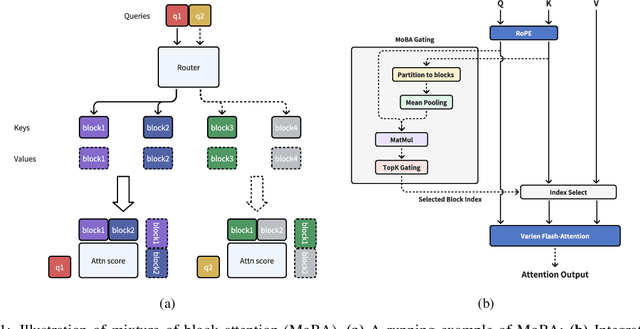

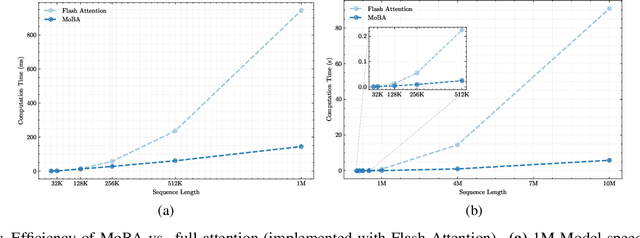
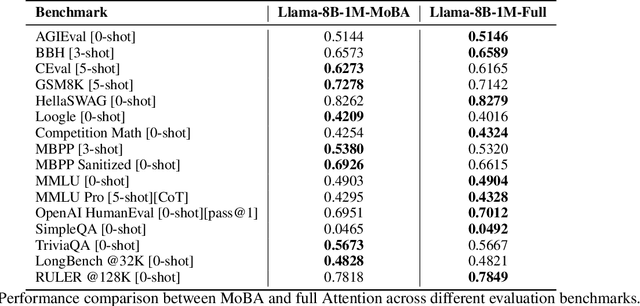
Abstract:Scaling the effective context length is essential for advancing large language models (LLMs) toward artificial general intelligence (AGI). However, the quadratic increase in computational complexity inherent in traditional attention mechanisms presents a prohibitive overhead. Existing approaches either impose strongly biased structures, such as sink or window attention which are task-specific, or radically modify the attention mechanism into linear approximations, whose performance in complex reasoning tasks remains inadequately explored. In this work, we propose a solution that adheres to the ``less structure'' principle, allowing the model to determine where to attend autonomously, rather than introducing predefined biases. We introduce Mixture of Block Attention (MoBA), an innovative approach that applies the principles of Mixture of Experts (MoE) to the attention mechanism. This novel architecture demonstrates superior performance on long-context tasks while offering a key advantage: the ability to seamlessly transition between full and sparse attention, enhancing efficiency without the risk of compromising performance. MoBA has already been deployed to support Kimi's long-context requests and demonstrates significant advancements in efficient attention computation for LLMs. Our code is available at https://github.com/MoonshotAI/MoBA.
SEPT: Towards Scalable and Efficient Visual Pre-Training
Dec 11, 2022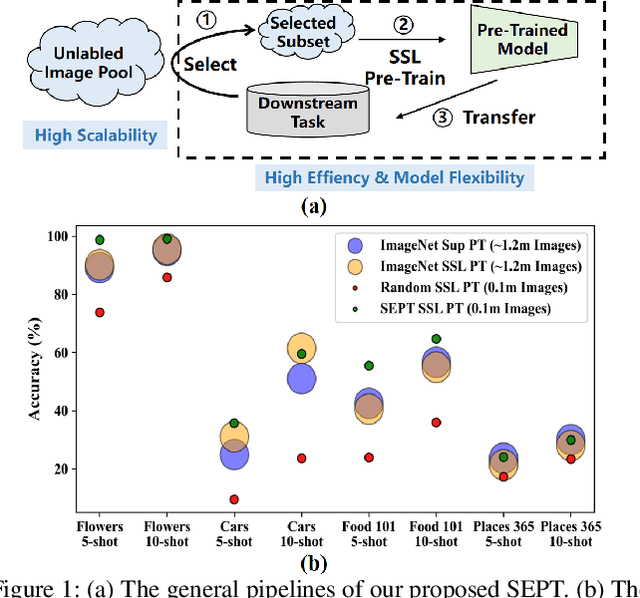
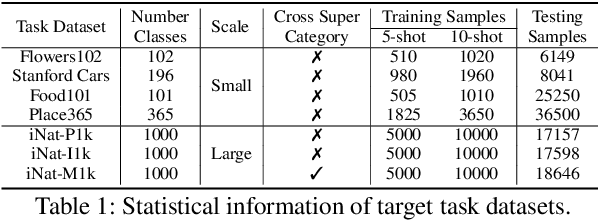

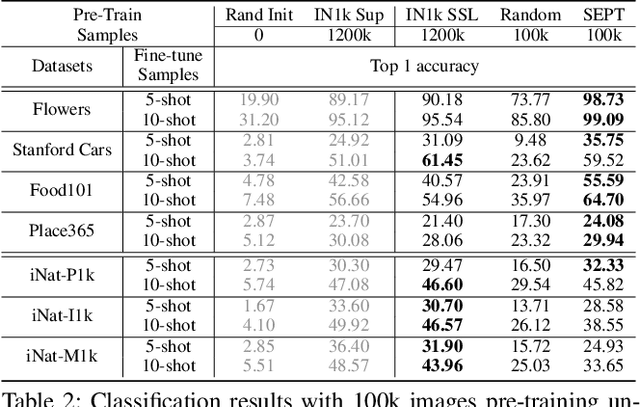
Abstract:Recently, the self-supervised pre-training paradigm has shown great potential in leveraging large-scale unlabeled data to improve downstream task performance. However, increasing the scale of unlabeled pre-training data in real-world scenarios requires prohibitive computational costs and faces the challenge of uncurated samples. To address these issues, we build a task-specific self-supervised pre-training framework from a data selection perspective based on a simple hypothesis that pre-training on the unlabeled samples with similar distribution to the target task can bring substantial performance gains. Buttressed by the hypothesis, we propose the first yet novel framework for Scalable and Efficient visual Pre-Training (SEPT) by introducing a retrieval pipeline for data selection. SEPT first leverage a self-supervised pre-trained model to extract the features of the entire unlabeled dataset for retrieval pipeline initialization. Then, for a specific target task, SEPT retrievals the most similar samples from the unlabeled dataset based on feature similarity for each target instance for pre-training. Finally, SEPT pre-trains the target model with the selected unlabeled samples in a self-supervised manner for target data finetuning. By decoupling the scale of pre-training and available upstream data for a target task, SEPT achieves high scalability of the upstream dataset and high efficiency of pre-training, resulting in high model architecture flexibility. Results on various downstream tasks demonstrate that SEPT can achieve competitive or even better performance compared with ImageNet pre-training while reducing the size of training samples by one magnitude without resorting to any extra annotations.
Semantically Coherent Out-of-Distribution Detection
Aug 26, 2021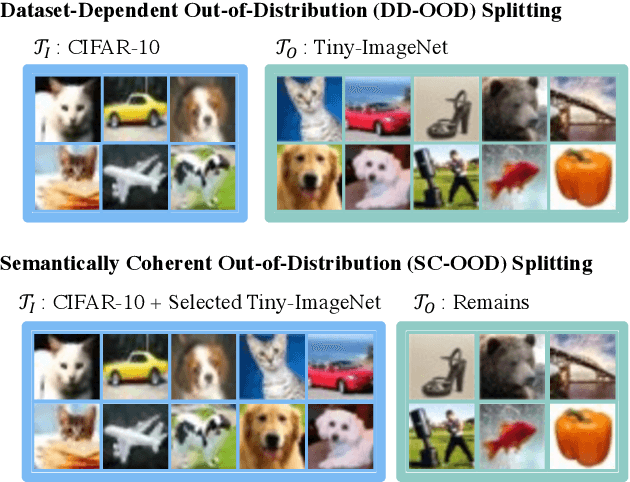

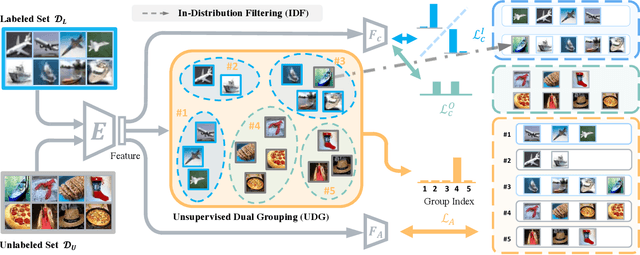
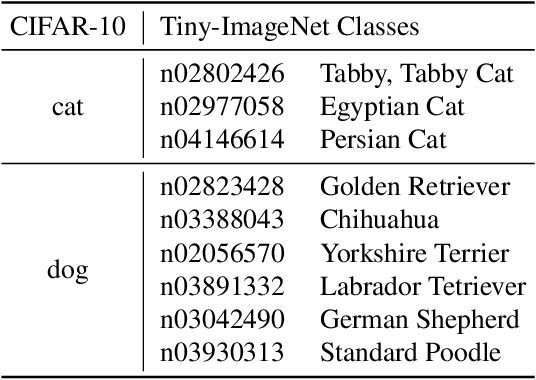
Abstract:Current out-of-distribution (OOD) detection benchmarks are commonly built by defining one dataset as in-distribution (ID) and all others as OOD. However, these benchmarks unfortunately introduce some unwanted and impractical goals, e.g., to perfectly distinguish CIFAR dogs from ImageNet dogs, even though they have the same semantics and negligible covariate shifts. These unrealistic goals will result in an extremely narrow range of model capabilities, greatly limiting their use in real applications. To overcome these drawbacks, we re-design the benchmarks and propose the semantically coherent out-of-distribution detection (SC-OOD). On the SC-OOD benchmarks, existing methods suffer from large performance degradation, suggesting that they are extremely sensitive to low-level discrepancy between data sources while ignoring their inherent semantics. To develop an effective SC-OOD detection approach, we leverage an external unlabeled set and design a concise framework featured by unsupervised dual grouping (UDG) for the joint modeling of ID and OOD data. The proposed UDG can not only enrich the semantic knowledge of the model by exploiting unlabeled data in an unsupervised manner, but also distinguish ID/OOD samples to enhance ID classification and OOD detection tasks simultaneously. Extensive experiments demonstrate that our approach achieves state-of-the-art performance on SC-OOD benchmarks. Code and benchmarks are provided on our project page: https://jingkang50.github.io/projects/scood.
Progressive Representative Labeling for Deep Semi-Supervised Learning
Aug 13, 2021



Abstract:Deep semi-supervised learning (SSL) has experienced significant attention in recent years, to leverage a huge amount of unlabeled data to improve the performance of deep learning with limited labeled data. Pseudo-labeling is a popular approach to expand the labeled dataset. However, whether there is a more effective way of labeling remains an open problem. In this paper, we propose to label only the most representative samples to expand the labeled set. Representative samples, selected by indegree of corresponding nodes on a directed k-nearest neighbor (kNN) graph, lie in the k-nearest neighborhood of many other samples. We design a graph neural network (GNN) labeler to label them in a progressive learning manner. Aided by the progressive GNN labeler, our deep SSL approach outperforms state-of-the-art methods on several popular SSL benchmarks including CIFAR-10, SVHN, and ILSVRC-2012. Notably, we achieve 72.1% top-1 accuracy, surpassing the previous best result by 3.3%, on the challenging ImageNet benchmark with only $10\%$ labeled data.
Webly Supervised Image Classification with Metadata: Automatic Noisy Label Correction via Visual-Semantic Graph
Oct 12, 2020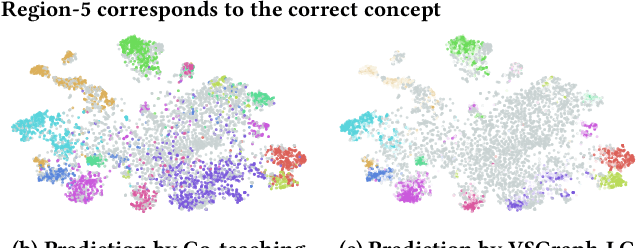
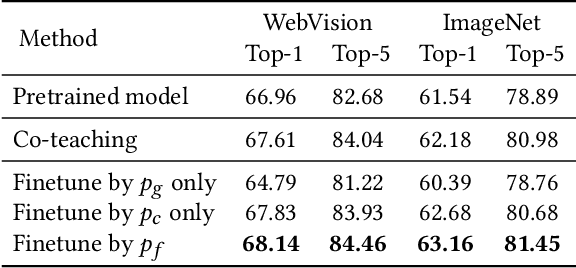
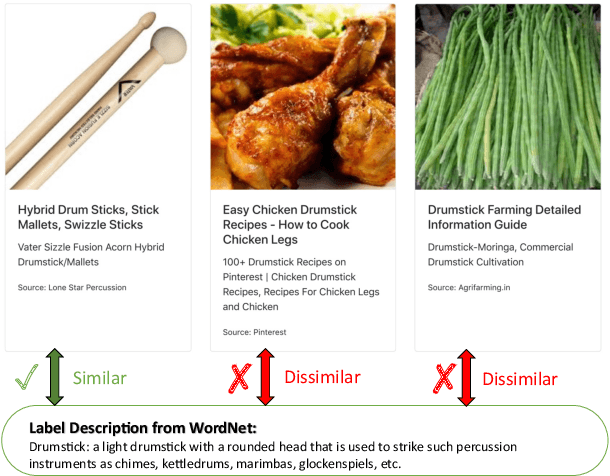
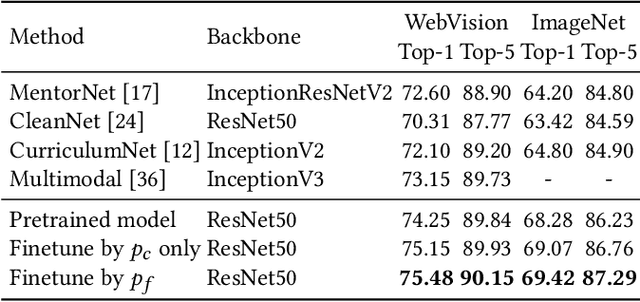
Abstract:Webly supervised learning becomes attractive recently for its efficiency in data expansion without expensive human labeling. However, adopting search queries or hashtags as web labels of images for training brings massive noise that degrades the performance of DNNs. Especially, due to the semantic confusion of query words, the images retrieved by one query may contain tremendous images belonging to other concepts. For example, searching `tiger cat' on Flickr will return a dominating number of tiger images rather than the cat images. These realistic noisy samples usually have clear visual semantic clusters in the visual space that mislead DNNs from learning accurate semantic labels. To correct real-world noisy labels, expensive human annotations seem indispensable. Fortunately, we find that metadata can provide extra knowledge to discover clean web labels in a labor-free fashion, making it feasible to automatically provide correct semantic guidance among the massive label-noisy web data. In this paper, we propose an automatic label corrector VSGraph-LC based on the visual-semantic graph. VSGraph-LC starts from anchor selection referring to the semantic similarity between metadata and correct label concepts, and then propagates correct labels from anchors on a visual graph using graph neural network (GNN). Experiments on realistic webly supervised learning datasets Webvision-1000 and NUS-81-Web show the effectiveness and robustness of VSGraph-LC. Moreover, VSGraph-LC reveals its advantage on the open-set validation set.
 Add to Chrome
Add to Chrome Add to Firefox
Add to Firefox Add to Edge
Add to Edge